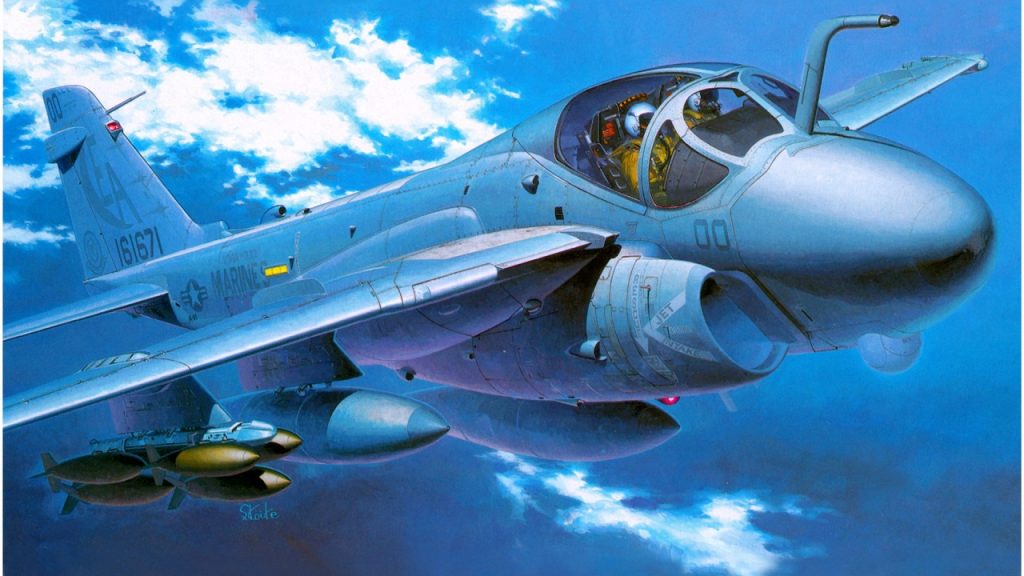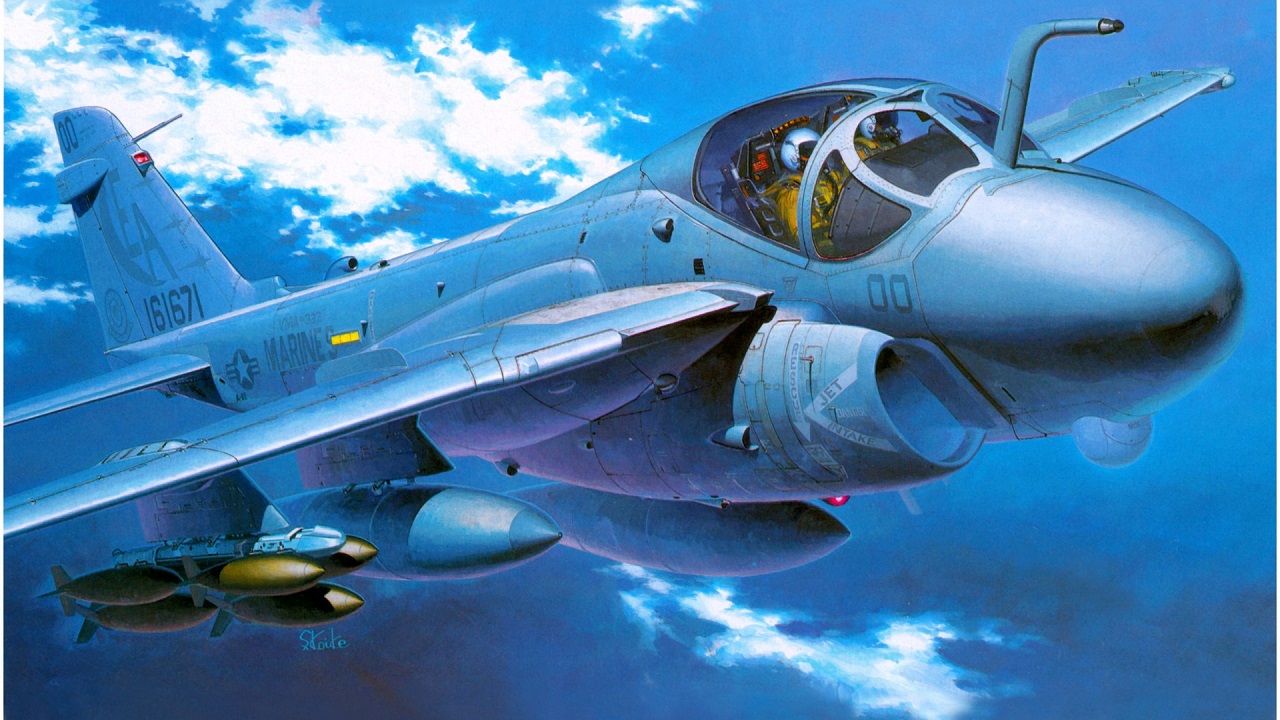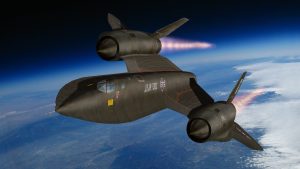The plane which sparked my interest in military aviation was a bulbous, slow, docile-looking jet: the all-weather A-6 Intruder.

I have always been fixated on military aviation, which is naturally one of the reasons I joined the US Air Force on a pilot contract (from which I was medically discharged). I know exactly which plane sparked my interest in military aviation, too. It wasn’t what you’d expect; not the supersonic SR-71 Blackbird, the romantic P-51 Mustang, or the stealthy F-117. It was a bulbous, slow, docile-looking jet: the all-weather A-6 Intruder.
I was still just a kid when the A-6 was retired from service in 1997, so I never got to see the thing in action. And in the quarter-century since its retirement, the jet has begun to fade into obscurity – which makes sense given the jet’s unassuming nature. But the A-6 was a highly capable attack aircraft that served for 36 years in both the US Navy and the US Marine Corps.
What would become the A-6 began when the Bureau of Aeronautics requested designs for an all-weather attack aircraft capable of performing short-distance takeoff and landings. Further, the jet needed to be able to perform long-range interdiction missions (for the Navy) and provide close air support (for the Marines). Initially, the A-6 was meant to directly replace the Douglas A-1 Skyraider – but the A-1 managed to stay in service a little longer, overlapping with the A-6 for ten years until 1973 – at which point the World War II-designed A-1 was a dinosaur.
While creating the A-6, designers were excited to drop in a turbine engine (the A-1 didn’t have a turbine engine and was confined to fair weather operations as a result). The new jet would be able to operate in all-weather conditions. The call for turbine engine-based designs led to eleven applications being submitted (from eight companies). Boeing, Lockheed, North American, Bell, and Douglas all put their hats in the ring. Grumman won the contract – and they would soon win a far more lucrative and prestigious contract: the Lunar Excursion Module that Apollo astronauts would land on the moon.
Grumman’s finished product entered service in 1963; the A-6 was billed as the world’s first ever all-weather attack aircraft. One of the more peculiar aspects of the A-6 was that it arranged the two operators side-by-side. The pilot sat on the left. The bombardier/navigator sat on the right (and slightly behind the pilot so as to not impede the pilot’s field of vision). Of course, in most two-seaters, the navigator would be in the back, directly behind the pilot.
The A-6 also featured a Vertical Display Indicator (VDI) – a then cutting-edge instrument that projected a synthetic representation of the landscape in front of the A-6, which helped the crew navigate in the challenging conditions they were often asked to fly.
Curiously, unlike so many of its contemporaries, the A-6 was not capable of breaking the sound barrier. Instead, the A-6 plodded along at subsonic speed; the A-6 maxed out at 640 miles per hour, climbed at 7,620 feet per minute, and had a service ceiling of 42,400 feet – none of which are especially impressive. The jet’s g-limit was 6.5. Obviously, the A-6 was not built with the performance specifications demanded of some air superiority jets. Instead, the A-6 was built to hulk tons and tons of weaponry over enemy lines, regardless of the weather outside.
To carry weaponry, the A-6 had five hard points. Each hard point could handle about two tons. In all, the A-6 could handle nine tons of payload. The high capacity weapons payload came in handy during the Vietnam War, where the A-6 was heavily relied upon. Although the low-flying A-6 was often targeted; the Viet Cong shot down 84 A-6s during the Vietnam War and many A-6 crew members,
The all-weather A-6 Intruder, a bulbous, lumbering, docile jet, piqued my curiosity about military aviation.
I have always been interested in military aviation, so I joined the US Air Force as a pilot (but had to leave for health reasons). I remember which plane piqued my interest in military aviation. It was not the speedy SR-71 Blackbird, the romantic P-51 Mustang, or the stealthy F-117. The all-weather A-6 Intruder was slow, bulbous, and passive.
When the A-6 was discontinued in 1997, I was too young to see it. Furthermore, the plane has faded into obscurity in the quarter-century since its retirement, which makes sense considering its humble demeanor. The A-6 was a powerful attack aircraft that served the US Navy and Marine Corps for 36 years.
The Bureau of Aeronautics asked for plans for an attack plane that could take off, land short distances, and fly in any weather. It became the A-6. The jet had to undertake long-range Navy interdiction operations and close air support (for the Marines). The Douglas A-1 Skyraider was supposed to be replaced by the A-6, but it lasted ten years before being retired in 1973.
Designers of the A-6 were eager to add a turbine engine because the A-1 did not have one and was limited to fair-weather operations. The new jet would be weatherproof. Eleven applications were submitted for turbine engine-based designs (from eight companies), such as Boeing, Lockheed, North American, Bell, and Douglas bid. Grumman won the contract and would soon win a more valuable and prestigious deal: the Lunar Excursion Module that Apollo astronauts would land on the moon.
The A-6, Grumman’s finished product, entered service in 1963. The A-6’s side-by-side operators were unusual. On the left was the pilot. The bombardier/navigator sat on the right (slightly behind the pilot to avoid obstructing his view). Most two-seaters have the navigator behind the pilot.
The Vertical Display Indicator (VDI) on the A-6 made a fake landscape appear in front of the plane. It helped the crew find their way in tough situations.
Unlike many peers, the A-6 could not breach the sound barrier. The A-6 climbed at 7,620 feet per minute, maxed out at 640 miles per hour, and had a service ceiling of 42,400 feet, all subsonic. The jet’s g-limit was 6.5. The A-6 did not meet the requirements of air superiority jet performance. Instead, regardless of the weather, the A-6 was designed to carry tonnes of weapons over enemy lines. Five A-6 hard points carried weapons—two tonnes per hard point. The A-6 could carry nine tonnes. The A-6 was frequently used in the Vietnam War due to its heavy munitions payload. The low-flying A-6 was commonly targeted by the Viet Cong, who shot down 84 A-6s during the Vietnam War and imprisoned numerous A-6 crew members.uffered as prisoners of war.






